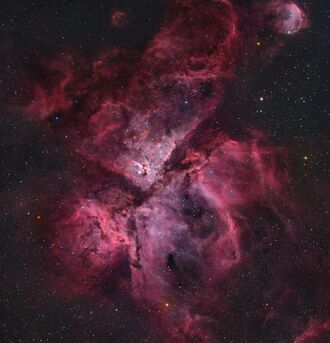Astronomy:HD 92063
| Observation data Equinox J2000.0]] (ICRS) | |
|---|---|
| Constellation | Carina |
| Right ascension | 10h 36m 20.51819s[1] |
| Declination | −59° 33′ 51.8102″[1] |
| Apparent magnitude (V) | 5.08[2] |
| Characteristics | |
| Spectral type | K1III[3] |
| B−V color index | 1.172±0.005[2] |
| Variable type | suspected[4] |
| Astrometry | |
| Radial velocity (Rv) | −10.15±0.19[1] km/s |
| Proper motion (μ) | RA: −40.984±0.229[1] mas/yr Dec.: −39.180±0.226[1] mas/yr |
| Parallax (π) | 13.2367 ± 0.1354[1] mas |
| Distance | 246 ± 3 ly (75.5 ± 0.8 pc) |
| Absolute magnitude (MV) | 0.55[2] |
| Details | |
| Mass | 1.2[5] M☉ |
| Radius | 13.85+0.26 −1.17[1] R☉ |
| Luminosity | 72.1±0.9[1] L☉ |
| Surface gravity (log g) | 2.25[5] cgs |
| Temperature | 4,520+204 −41[1] K |
| Metallicity [Fe/H] | +0.02[5] dex |
| Rotational velocity (v sin i) | <1.2[6] km/s |
| Other designations | |
| Database references | |
| SIMBAD | data |
HD 92063 is a single[8] star in the southern constellation of Carina. It has the Bayer designation t1 Carinae, while HD 92063 is the star's identifier from the Henry Draper Catalogue. This is a suspected variable star[4] and is visible to the naked eye with an apparent visual magnitude of 5.08.[2] The star is located at a distance of approximately 246 light years from the Sun based on parallax, but is drifting closer with a radial velocity of −10 km/s.[1] Although it appears at the edge of the Carina Nebula, it is much closer than the nebula. It is also not considered a member of the nearby Alessi 5 open cluster of stars.[9]
This is an aging K-type giant star with a stellar classification of K1III,[3] having exhausted the supply of hydrogen at its core then cooled and expanded off the main sequence. At present it has 14[1] times the radius of the Sun. The star is radiating 72[1] times the Sun's luminosity from its enlarged photosphere at an effective temperature of 4,520 K.[1]
References
- ↑ 1.00 1.01 1.02 1.03 1.04 1.05 1.06 1.07 1.08 1.09 1.10 1.11 1.12 Brown, A. G. A. (August 2018). "Gaia Data Release 2: Summary of the contents and survey properties". Astronomy & Astrophysics 616: A1. doi:10.1051/0004-6361/201833051. Bibcode: 2018A&A...616A...1G. Gaia DR2 record for this source at VizieR.
- ↑ 2.0 2.1 2.2 2.3 Anderson, E.; Francis, Ch. (2012), "XHIP: An extended hipparcos compilation", Astronomy Letters 38 (5): 331, doi:10.1134/S1063773712050015, Bibcode: 2012AstL...38..331A.
- ↑ 3.0 3.1 Houk, Nancy (1978), Michigan catalogue of two-dimensional spectral types for the HD stars, 1, Ann Arbor: Dept. of Astronomy, University of Michigan, Bibcode: 1975mcts.book.....H.
- ↑ 4.0 4.1 Samus', N. N; Kazarovets, E. V; Durlevich, O. V; Kireeva, N. N; Pastukhova, E. N (2017), "General catalogue of variable stars: Version GCVS 5.1", Astronomy Reports 61 (1): 80, doi:10.1134/S1063772917010085, Bibcode: 2017ARep...61...80S.
- ↑ 5.0 5.1 5.2 Anders, F.; Khalatyan, A.; Chiappini, C.; Queiroz, A. B.; Santiago, B. X.; Jordi, C.; Girardi, L.; Brown, A. G. A. et al. (2019), "Photo-astrometric distances, extinctions, and astrophysical parameters for Gaia DR2 stars brighter than G = 18", Astronomy and Astrophysics 628: A94, doi:10.1051/0004-6361/201935765, Bibcode: 2019A&A...628A..94A.
- ↑ De Medeiros, J. R.; Alves, S.; Udry, S.; Andersen, J.; Nordström, B.; Mayor, M. (2014), "A catalog of rotational and radial velocities for evolved stars", Astronomy & Astrophysics 561: A126, doi:10.1051/0004-6361/201220762, Bibcode: 2014A&A...561A.126D.
- ↑ "HD 92063". SIMBAD. Centre de données astronomiques de Strasbourg. http://simbad.u-strasbg.fr/simbad/sim-basic?Ident=HD+92063.
- ↑ Eggleton, P. P.; Tokovinin, A. A. (2008), "A catalogue of multiplicity among bright stellar systems", Monthly Notices of the Royal Astronomical Society 389 (2): 869, doi:10.1111/j.1365-2966.2008.13596.x, Bibcode: 2008MNRAS.389..869E.
- ↑ Cantat-Gaudin, T. et al. (July 2018), "Characterising open clusters in the solar neighbourhood with the Tycho-Gaia Astrometric Solution", Astronomy & Astrophysics 615: 15, doi:10.1051/0004-6361/201731251, A49, Bibcode: 2018A&A...615A..49C.
External links
- Ford, Dominic. "The star T¹-Car - In-The-Sky.org" (in en). https://in-the-sky.org/data/object.php?id=TYC8613-3366-1.
Coordinates: ![]() 10h 36m 20.3s, −59° 33′ 53″
10h 36m 20.3s, −59° 33′ 53″
 |


